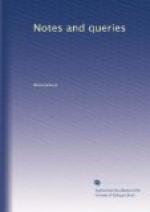(20.) To whom should we attribute the rare tract entitled Lauacrum conscientie omnium sacerdotum, which consists of fifty-eight leaves, and was printed in Gothic letter at Cologne, “Anno post Jubileum quarto?”
(21.) Where can information be met with as to the authorship of the Dialogus super Libertate Ecclesiastica, between Hugo, Cato, and Oliver? Fischer (Essai sur Gutenberg, 79.) traces back the first edition to the year 1463; but I know the treatise only in the form in which it was republished at Oppenheim in 1516.
(22.) Who was the compiler or curator of the Viola Sanctorum? and can the slightest attempt be made at verifying the signatures and numbers inserted in the margin, and apparently relating to the MSS. from which the work was taken? One of two copies before me was printed at Nuremberg in 1486, but the other I believe to belong to the earliest impression. It is of small folio size, in very Gothic type, perhaps of the year 1472, without date, place, or name of printer, and is destitute of cyphers, catchwords, and signatures. There are ninety-two leaves in the volume, and in each page generally thirty-three (sometimes thirty-four, rarely thirty-five) lines. (See Brunet, iii. 547.; Kloss, 280.; Panzer, i. 193.)
(23.) By what means can intelligence be procured respecting “Doctor Ulricus,” the author of Fraternitas Cleri? A satisfactory reply to this inquiry might probably be found in the Bibl. Spenceriana; but I have not now an opportunity of determining this point.
(24.) A question has been raised by Dr Maitland, from whose admirable criticism nothing connected with literature is likely to escape, as to the meaning of the letters “P.V.” placed over a sudarium held by St. Peter and St. Paul. (Early printed Books in the Lambeth Library, pp. 115. 368.) Any person who has happened to obtain the Vitas Patrum, decorated with the curious little woodcuts of which Dr. Maitland has carefully represented two, will cheerfully agree with him in maintaining the excellence of the acquisition. In a copy of this work bearing date 1520, eleven years later than the Lambeth volume (List, p. 85.), the reverse of the leaf which contains the colophon exhibits the same sudarium, in company with the words “Salve sancta Facies.” This circumstance inclines me to venture to ask whether my much-valued friend will concur with me in the conjecture that Pictura Veronicae may be the interpretation of “P.V.?” Though the pseudo-Archbishop of Westminster declared, in the simplicity of his heart (Letters to John Poynder, Esq., p. 6.), that he had “never met” with the sequence “quae dicitur in Missa Votiva de Vultu Sancto,” doubtless some of his newly-arrested subjects are {441} well aware that it exists, and that its commencement (see Bona, iii. 144.) is,—
“Salve sancta Facies nostri Redemptoris,
In qua nitet species divini splendoris,
Impressa panniculo nivei candoris,
Dataque Veronicae signum ob amoris.”




